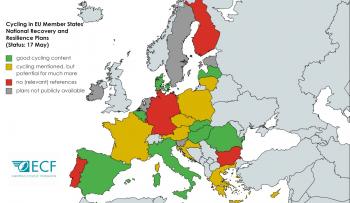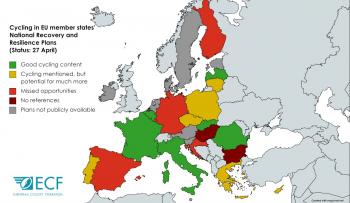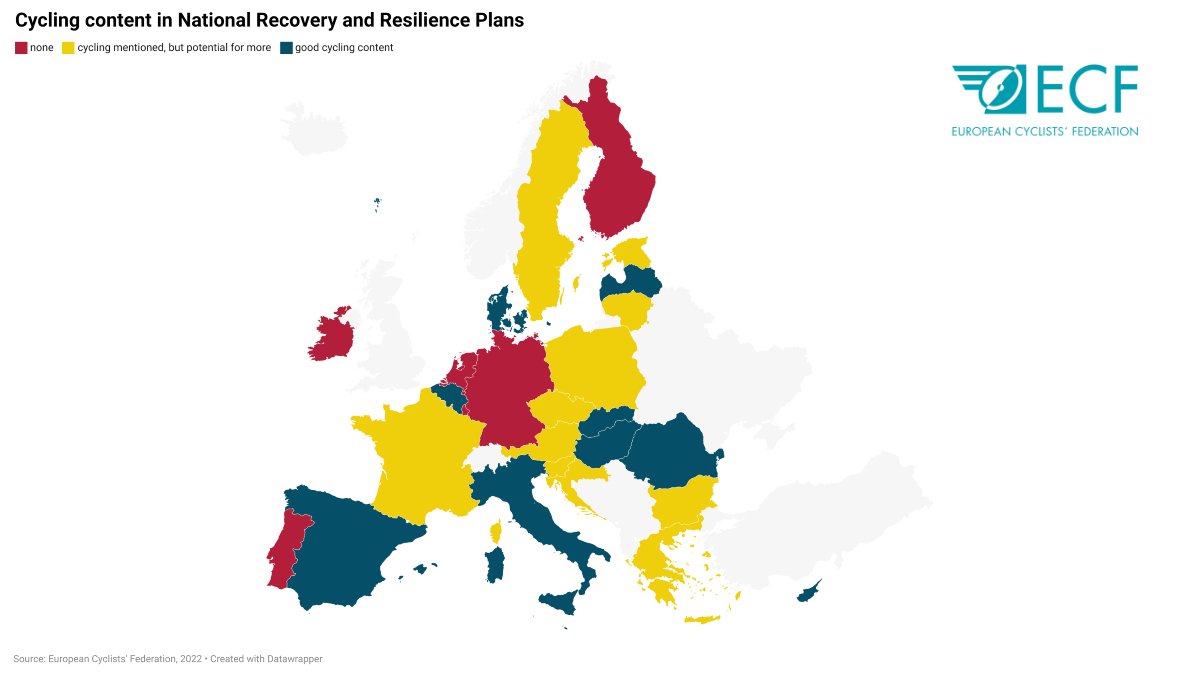
Cycling investments in the NextGenerationEU stimulus package: Taking stock
ECF takes a look at how EU Member States' National Recovery and Resilience Plans are faring in their commitments to cycling. In August 2021, we estimated overall investments to be as much as €1.7 billion.
In 2021, EU Member States adopted their National Recovery and Resilience Plans (NRRPs) under the EU’s €800 billion “NextGenerationEU” stimulus package. Thanks to concerted advocacy efforts of ECF and its members, many national plans contained measures for and investments in cycling.
In our last analysis from August 2021, we estimated investments in cycling in the NRRPs to reach €1.7 billion. Now, after more than €90 billion of grants under the Recovery and Resilience Facility have been disbursed to Member States (around one quarter of the total maximum grant amount), it is time to take stock and present some examples of cycling projects that have been financed through “NextGenerationEU”.
The country that had proposed the most cycling investments in absolute terms in its NRRP, according to our analysis, was Italy, with investments of €600 million to finance the construction of 1,200 km of touristic cycle paths and around 570 km of urban cycling infrastructure until 2026. In the meantime, this proposal has been embedded in a comprehensive national cycling plan and it has also become more concrete, with financial allocations to 45 cities with more than 50,000 inhabitants for the urban infrastructure part, and the designation of the touristic long-distance cycling routes that will benefit from the funds – parts of them also coincide with the four EuroVelo routes running across Italy: 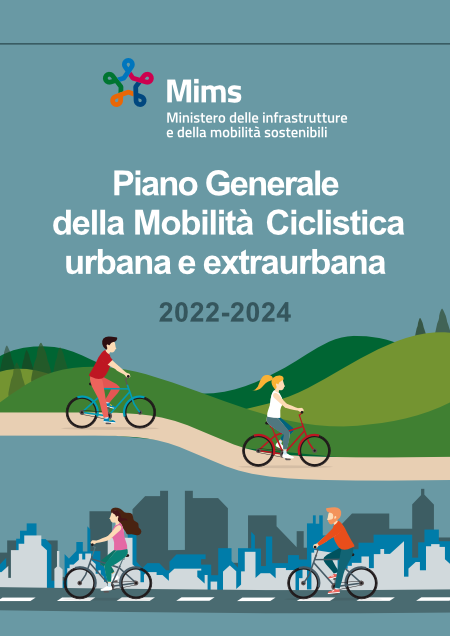
- €74 million to the Adriatic cycle route
- €61.5 million to the Magna Grecia cycle route (Basilicata-Calabria-Sicily)
- €51 million to the Vento cycle route (Venice-Turin)
- €44.5 million to the Tyrrhenian cycle route
- €22.5 million to the Sole cycle route (Verona-Florence)
- €39.5 million for the Puglia Aqueduct cycle route (from Caposele in the province of Avellino to Santa Maria di Leuca in the province of Lecce through Campania, Basilicata and Puglia)
- €33 million to the Sardinia cycle route
- €30 million to the Garda cycle route
- €30 million to the Trieste-Lignano-Sabbiadoro-Venice cycle route
- €14 million to the Grab (Rome's Grande Raccordo Anulare bicycle ring road).
Another country with substantial investments is Spain. Even though the commitments in the NRRP itself were a bit more vague in terms of quantitative targets than in Italy, the implementation phase of the plan made them more concrete and shows that the Spanish government is using the funding from NextGenerationEU to improve cycling conditions.
For the first time, it has developed a national cycling strategy and claims to have mobilised €500 million for cycling with the help of the Recovery and Resilience Facility, enough to finance ca. 1,000 km of cycling paths, 4,100 secure bicycle parking facilities, and the strengthening of public bike sharing systems in 30 cities. The calls published by the government show that this money is also effectively spent on the ground, for example for cycling infrastructure in the city of Pamplona, or the expansion of the public bike share system in Palma de Mallorca and in the Metropolitan Area of Barcelona.

Pamplona is set to expand its electric bicycle rental service, investing €1.39 million towards installing 20 new stations throughout the city and acquiring 240 electric bikes (Source: pamplona.es)
On the other side of the continent, and after advocacy efforts of ECF Member Romanian Cyclists’ Federation, Romania also had proposed significant investments in cycling in its NRRP, with €120 million set to fund, amongst others, the establishment of more than 3,000 km of touristic cycle routes, including along EuroVelo 6 – the Atlantic-Black Sea cycle route. The government has recently made this commitment more concrete and published the rules and funding conditions for the establishment of these routes.
The investment amount now mentioned in the funding conditions is €247.5 million, which would be a substantial increase from last year’s estimation. The interest of Romanian local authorities in funding for cycling infrastructure also became obvious when in November 2022, dozens of projects were submitted within seconds after the opening of a dedicated call. For example, the capital Bucharest’s Sector 2 plans to build 36 km of urban cycling infrastructure with funding from the NRRP, increasing the length of existing infrastructure four times over.
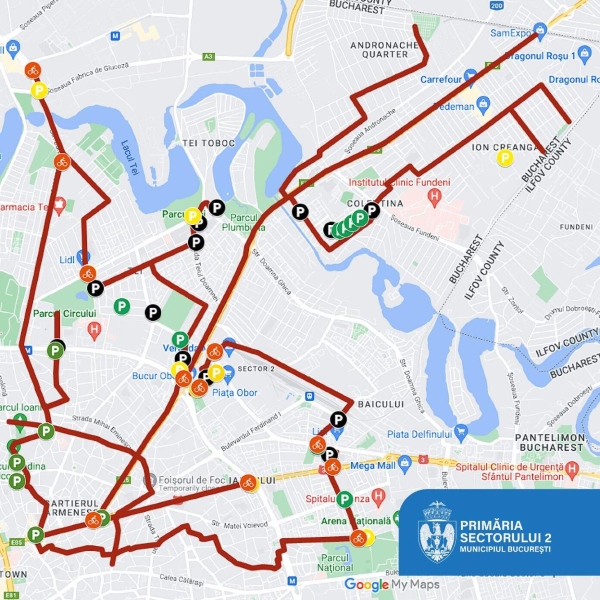
Mayor Radu Mihaiu announced that over 36 kilometers of bicycle paths will be built in Bucharest's Sector 2 through the NRRP (Source: romanialibera.ro)
Another country that has made investments in cycling one of the focal points of its NRRP is Belgium, with a total amount of €400 million. Due to the federal nature of the country, the investments are split between the regions. The Flemish Region wants to invest €345 million in renovating 1,350 km of existing cycling infrastructure and building 140 km of new infrastructure; the Brussels Capital Region is planning investments of €34 million in at least 7,000 new and secure bicycle parking spaces and 22 km of new infrastructure; and the Walloon Region wants to invest €14 million mainly in cycle highways connecting the province of Walloon Brabant with Brussels. A few projects, for example the renovation of cycle paths in the Flemish areas around Brussels that will mainly benefit cycle commuters, have already been carried out.
Slovakia has committed to substantial investments of more than €100 million in its NRRP, but in addition to this and after successful advocacy of Slovakian ECF Member Cyklokoalícia, the government has also included other measures in the plan, such as the adoption of a new methodology for assessing project applications in the field of cycling infrastructure, allowing a more efficient allocation of financial resources. In its assessment of Slovakia’s first payment request for grants under the Recovery and Resilience Facility, the European Commission has given a positive evaluation of this methodology, which is in place since February 2022 and includes a cost-benefit analysis for cycling projects.
Finally, in Greece the Region of Attica has recently announced more concrete plans for the construction of pedestrian and cycling infrastructure along the coast of Athens (the “Athenian Riviera”) for €25 million, financed through the NRRP and to be completed by the end of 2025.
Regions:
Contact the author
Recent news!
Upcoming events
Contact Us
Avenue des Arts, 7-8
Postal address: Rue de la Charité, 22
1210 Brussels, Belgium


